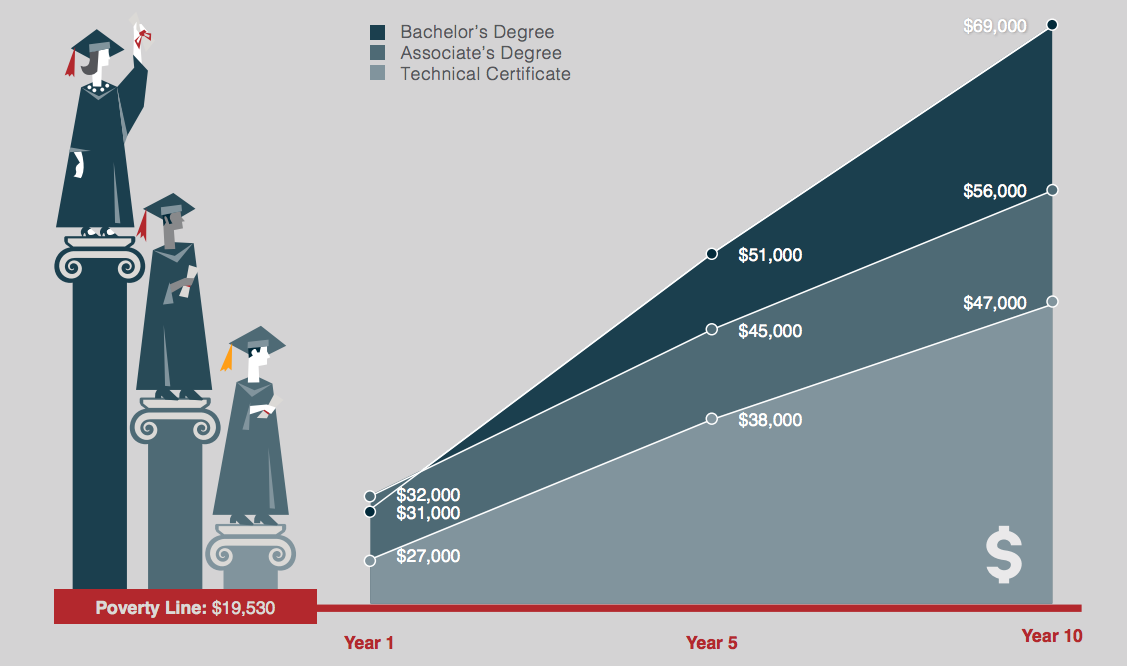Education reformers are obsessed with getting many more low-income students “to and through” four-year colleges. Understandably so, a bachelor’s degree is the closest thing we have to a guaranteed ticket to the middle class. The trouble is, few children from poorer homes are likely to end up with a BA. As Andrew Kelly of the American Enterprise Institute shows in his chapter of my new book, just 14 percent of children from the bottom third of the income distribution will complete four-year degrees. Even if we doubled that number, most poor and working class kids will still need other paths to the middle class.
“Bachelor’s degree or bust”: A failed strategy
The academic-dominated approach is not working, especially for economically disadvantaged students. Of this group, about 20 percent of teenagers don’t graduate from high school at all. Of those who do graduate, about half matriculate to some form of college. But many are not ready: two-thirds of low-income students at community colleges start in remedial classes. Here’s where things really fall apart. Only a third of community college students who start in remedial courses complete a credential within six years. Forty percent don’t ever get beyond the remedial stage. The common outcome of our current strategy—“bachelor’s degree or bust”—is that a young person drops out of college at age 20 with no post-secondary credential, no skills, and no work experience, but a fair amount of debt. That’s a terrible way to begin adult life, and it’s even worse if the young adult aims to escape poverty.
Technical education for social mobility
A better approach for many young people would be to develop coherent pathways, beginning in high school, into authentic technical education options at the post-secondary level. But, right now, 81 percent of high school students are taking an academic route; only 19 percent are “concentrating” in career and technical education (i.e., earning at least three credits in a single CTE program area). As Tamar Jacoby demonstrates, high-quality career and technical education (CTE) programs, culminating in industry-recognized post-secondary credentials, have great promise in engaging students, helping them succeed academically, boosting college completion rates, and brightening career prospects. By age 20, graduates of such programs have academic credentials, technical credentials, and work experience—and, usually, well-paying jobs:  There is a fear of ‘tracking’ in high school, for obvious reasons. But it simply doesn’t work to wait until kids are 18. Generic high school experiences are not preparing low-income students to successfully pursue either academic or technical routes after they receive their diplomas. A student must be able to choose their own path. But there should be a real choice. The education system alone cannot solve persistent poverty or the growing gaps between working-class and college-educated Americans. But it can do a lot better. If we are serious about social mobility, we need to move past the singular obsession with four-year colleges, and give more weight to career and technical education. Michael J. Petrilli is president of the Thomas B. Fordham Institute, research fellow at the Hoover Institution, and editor of Education for Upward Mobility .
There is a fear of ‘tracking’ in high school, for obvious reasons. But it simply doesn’t work to wait until kids are 18. Generic high school experiences are not preparing low-income students to successfully pursue either academic or technical routes after they receive their diplomas. A student must be able to choose their own path. But there should be a real choice. The education system alone cannot solve persistent poverty or the growing gaps between working-class and college-educated Americans. But it can do a lot better. If we are serious about social mobility, we need to move past the singular obsession with four-year colleges, and give more weight to career and technical education. Michael J. Petrilli is president of the Thomas B. Fordham Institute, research fellow at the Hoover Institution, and editor of Education for Upward Mobility .








Commentary
Not just college: Technical education as a pathway to the middle class
April 1, 2016